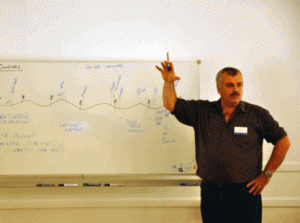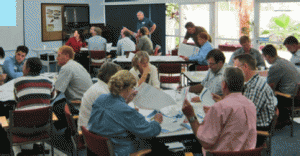This week’s blogger is Neil Cliffe, from Agri-Science Queensland. Neil is the manager of the Climate Risk and Adaptation Project in Queensland, Australia. This blog post is part of a series on the extreme climate shifts that have been occurring in Australia; in which the region went from terrible drought (Part I-The need for rain) to devastating floods (Part II-When it rains, it pours).
Discussing climate change with people can sometimes be challenging. We all live in a world that is intimately influenced by the climate around us. At a most basic level we experience variations season by season in variables such as temperature and precipitation. This seasonal variation is more obvious in temperate regions of the world, but evident wherever we live, even in the tropics and sub-tropics. Some of us have lived through extreme weather events that can have a profound impact on our lives, many of which are negative, but some of which have positive impacts too. For example, we can think of the negative impact of extreme floods, but the positive impact that floods may bring to water supplies in dams and for agriculture production more generally.
Reconciling the climate we live in, which changes constantly, with the concept of climate change as a result of rising CO2 concentrations in our atmosphere can be a difficult concept to understand. Views can be polarized by the different interpretations of data to fit one perspective or another, in addition to the role of the media in sensationalizing the issue for their own ends. However, the majority of climate scientists agree that climate change is occurring and that atmospheric greenhouse gas concentrations, global temperature, and sea level are rising at rates that are unprecedented in the geological record.
How do we work with people who have different views and different knowledge bases to discuss this globally important issue? In climate change adaptation workshops in Queensland, Australia, our goals are to raise awareness of climate variability and climate change projections at a regional level. Then, we provide a structured discussion process, which challenges people to think about both the negative and positive impacts that a particular climate variable may have on an industry, community, or situation. Finally, we consider what potential adaptation responses might be appropriate to respond to those impacts.
At the start of these workshops, we develop a 60-year timeline to collect group member’s experiences of climate and weather events that they have experienced in their lifetimes in the regions where they live. Common examples that people provide include floods, droughts, heatwaves, fires, storms or cyclone/hurricanes. We then challenge them to consider if they have noticed any trends in these events over their lifetimes. This is a more challenging question and some people will say that there is no trend, it’s just natural climate variability. However, others suggest that winters are getting warmer, the intensity of storms is greater, or that the pattern of afternoon storms in spring has changed in their lifetimes. Others have noticed changes in biological systems. For example, fishermen have noticed changes in the distribution and timing of catch for some fish species off the Queensland coast, with some species even disappearing in particular regions.
This ‘timeline’ exercise acknowledges local experience without judging perspectives that might be skeptical about the existence of climate change over and above natural climate variability. In every workshop where we have used this technique, someone has identified a trend, or drawn a conclusion, that the outcome may be related to climate change. In a sense, this then gives local permission to further discuss and consider regional climate records and what the science is saying in terms of regional climate change projections. Thus, after this initial exercise we then share what the science says about climate in the region and go on to discuss in small groups the impacts and possible adaptation responses using a risk management approach.
From these workshops, I’ve come to believe that building understanding through recognizing local knowledge and experience, matched with the deeper insights that science provides, can lead to collaborative approaches that support people, industries, and communities to better respond to both natural climate variability and climate change impacts.
Suggested activity: How could you use the timeline exercise, as described in this post, in your classroom or community to encourage discussion on climate change? Gathering experiential knowledge from people in your community using the timeline exercise to then compare with scientific data analysis would make an interesting research project to share with the GLOBE community! We’d love to hear your thoughts—send us an email or post a comment!



It is very likely that several of the unprecedented extremes of the past decade would not have occurred without anthropogenic global warming.
What I feel is that, the best strategy would be to introduce some specific course about this in schools and colleges. There should be a practical effort involved by students. Because, it’s not so easy to reach, or convert, the minds of this generation. But at least, what we have in our hands is our next generation, which can do much better things than us. We just need to prepare their minds for this.
It sounds like we are having the same weather in West Texas, US. About 4 years ago we had tropic moisture come in the at the tail end of fall and we got some great rainfall leading into the fall of the year. The following spring we had no moisture at all but,had abundance of dead vegetation so, the grass fires started multiplying all year till very late fall. Our area where I live looks like a war zone and our underground water supply and lakes are all nearly dry. Great information and understand completely.
This is now often the case that climate change is quite extreme, when the rainy season it rains quite a long time and cause flooding, as well as the summer heat increases, causing all of us can not stand when activity outside the home. And this is hardly the case in all countries
floods, heat, high winds, are the effects of climate change. keep on how to solve it? lack of awareness of every human being on the causes of climate change so difficult to overcome.
even though everyone already knows the causes and consequences of climate change, but it is difficult to arrange them to do something does not result in extreme climate change. it all depends on the conscience of each individual